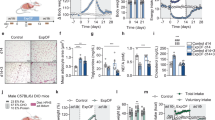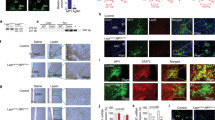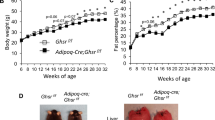Abstract
Background:
αMUPA mice carry as a transgene the cDNA encoding urokinase-type plasminogen activator, a member of the plasminogen/plasmin system that functions in fibrinolysis and extracellular proteolysis. These mice spontaneously consume less food when fed ad libitum and live longer compared with wild-type (WT) control mice. αMUPA mice are obesity resistant and they share many similarities with calorically restricted animals. However, extensive metabolic characterization of this unique transgenic model has never been performed.
Method:
Metabolism of αMUPA mice was analyzed by measuring hormone, lipid and glucose levels in the serum, as well as gene and protein expression levels in the liver, hypothalamus and brainstem.
Results:
αMUPA mice were found to be leaner than WT mice mainly because of reduced fat depots. Serum analyses showed that αMUPA mice have high levels of the anorexigenic hormones insulin and leptin, and low levels of the orexigenic hormone ghrelin. Analyses of brain neuropeptides showed that the transcript of the anorexigenic neuropeptide Pomc is highly expressed in the brainstem, whereas the expression of the orexigenic neuropeptides Npy, Orexin and Mch is blunted in the hypothalamus of αMUPA mice. In addition, adenosine monophosphate (AMP)-activated protein kinase (AMPK) levels were higher in the liver and lower in the hypothalamus, thus promoting simultaneously central reduction in appetite and peripheral loss of fat. The levels of SIRT1 were low in the liver, but high in the hypothalamus, a feature that αMUPA mice share with calorically restricted animals.
Conclusion:
Taken together, αMUPA mice exhibit a unique metabolic phenotype of low-calorie intake and high leptin levels, and could serve as a model for both spontaneous calorie restriction and resistance to obesity.
This is a preview of subscription content, access via your institution
Access options
Subscribe to this journal
Receive 12 print issues and online access
$259.00 per year
only $21.58 per issue
Buy this article
- Purchase on Springer Link
- Instant access to full article PDF
Prices may be subject to local taxes which are calculated during checkout







Similar content being viewed by others
References
Cone RD . Anatomy and regulation of the central melanocortin system. Nat Neurosci 2005; 8: 571–578.
Toshinai K, Date Y, Murakami N, Shimada M, Mondal MS, Shimbara T et al. Ghrelin-induced food intake is mediated via the orexin pathway. Endocrinology 2003; 144: 1506–1512.
Zhu Y, Yamanaka A, Kunii K, Tsujino N, Goto K, Sakurai T . Orexin-mediated feeding behavior involves both leptin-sensitive and -insensitive pathways. Physiol Behav 2002; 77: 251–257.
Kahn BB, Alquier T, Carling D, Hardie DG . AMP-activated protein kinase: ancient energy gauge provides clues to modern understanding of metabolism. Cell Metab 2005; 1: 15–25.
Andersson U, Filipsson K, Abbott CR, Woods A, Smith K, Bloom SR et al. AMP-activated protein kinase plays a role in the control of food intake. J Biol Chem 2004; 279: 12005–12008.
Kubota N, Yano W, Kubota T, Yamauchi T, Itoh S, Kumagai H et al. Adiponectin stimulates AMP-activated protein kinase in the hypothalamus and increases food intake. Cell Metab 2007; 6: 55–68.
Lopez M, Lage R, Saha AK, Perez-Tilve D, Vazquez MJ, Varela L et al. Hypothalamic fatty acid metabolism mediates the orexigenic action of ghrelin. Cell Metab 2008; 7: 389–399.
Minokoshi Y, Alquier T, Furukawa N, Kim YB, Lee A, Xue B et al. AMP-kinase regulates food intake by responding to hormonal and nutrient signals in the hypothalamus. Nature 2004; 428: 569–574.
Canto C, Auwerx J . Caloric restriction, SIRT1 and longevity. Trends Endocrinol Metab 2009; 20: 325–331.
Sauve AA, Wolberger C, Schramm VL, Boeke JD . The biochemistry of sirtuins. Annu Rev Biochem 2006; 75: 435–465.
Canto C, Auwerx J . PGC-1alpha, SIRT1 and AMPK, an energy sensing network that controls energy expenditure. Curr Opin Lipidol 2009; 20: 98–105.
Lin J, Wu PH, Tarr PT, Lindenberg KS, St-Pierre J, Zhang CY et al. Defects in adaptive energy metabolism with CNS-linked hyperactivity in PGC-1alpha null mice. Cell 2004; 119: 121–135.
Finck BN, Gropler MC, Chen Z, Leone TC, Croce MA, Harris TE et al. Lipin 1 is an inducible amplifier of the hepatic PGC-1alpha/PPARalpha regulatory pathway. Cell Metab 2006; 4: 199–210.
Koo SH, Satoh H, Herzig S, Lee CH, Hedrick S, Kulkarni R et al. PGC-1 promotes insulin resistance in liver through PPAR-alpha-dependent induction of TRB-3. Nat Med 2004; 10: 530–534.
Puigserver P, Wu Z, Park CW, Graves R, Wright M, Spiegelman BM . A cold-inducible coactivator of nuclear receptors linked to adaptive thermogenesis. Cell 1998; 92: 829–839.
Berger J, Moller DE . The mechanisms of action of PPARs. Annu Rev Med 2002; 53: 409–435.
Liang H, Ward WF . PGC-1alpha: a key regulator of energy metabolism. Adv Physiol Educ 2006; 30: 145–151.
Miskin R, Axelrod JH, Griep AE, Lee E, Belin D, Vassalli JD et al. Human and murine urokinase cDNAs linked to the murine alpha A-crystallin promoter exhibit lens and non-lens expression in transgenic mice. Eur J Biochem 1990; 190: 31–38.
Mondino A, Blasi F . uPA and uPAR in fibrinolysis, immunity and pathology. Trends Immunol 2004; 25: 450–455.
Soreq H, Miskin R . Plasminogen activator in the developing rat cerebellum: biosynthesis and localization in granular neurons. Brain Res 1983; 313: 149–158.
Sumi Y, Dent MA, Owen DE, Seeley PJ, Morris RJ . The expression of tissue and urokinase-type plasminogen activators in neural development suggests different modes of proteolytic involvement in neuronal growth. Development 1992; 116: 625–637.
Masos T, Miskin R . mRNAs encoding urokinase-type plaminogen activator and plasminogen activator inhibitor-1 are elevated in the mouse brain following kainate-mediated excitation. Brain Res Mol Brain Res 1997; 47: 157–169.
Bahi A, Boyer F, gumy C, Kafri T, Dreyer JL . In vivo gene delivery of urokinase-type plasminogen activator with regulatable lentivirus induces behavioural changes in chronic cocaine administration. Eur J Neurosci 2004; 20: 3473–3488.
Bahi A, Dreyer JL . Overexpression of plasminogen activators in the nucleus accumbens enhances cocaine-, amphetamine- and morphine-induced reward and behavioral sensitization. Genes Brain Behav 2008; 7: 244–256.
Lahtinen L, Lukasiuk K, Pitkanen A . Increased expression and activity of urokinase-type plasminogen activator during epileptogenesis. Eur J Neurosci 2006; 24: 1935–1945.
Miskin R, Tirosh O, Pardo M, Zusman I, Schwartz B, Yahav S et al. alphaMUPA mice: a transgenic model for longevity induced by caloric restriction. Mech Ageing Dev 2005; 126: 255–261.
Miskin R, Masos T, Shoham Z, Williams-Simons L . Urokinase-type plasminogen activator mRNA is expressed in normal developing teeth and leads to abnormal incisor enamel in alpha MUPA transgenic mice. Transgenic Res 2006; 15: 241–254.
Miskin R, Masos T . Transgenic mice overexpressing urokinase-type plasminogen activator in the brain exhibit reduced food consumption, body weight and size, and increased longevity. J Gerontol A Biol Sci Med Sci 1997; 52: B118–B124.
Miskin R, Masos T, Yahav S, Shinder D, Globerson A . alphaMUPA mice: a transgenic model for increased life span. Neurobiol Aging 1999; 20: 555–564.
Froy O, Miskin R . Effect of feeding regimens on circadian rhythms: implications for aging and longevity. Aging 2010; 2: 7–27.
Tirosh O, Aronis A, Zusman I, Kossoy G, Yahav S, Shinder D et al. Mitochondrion-mediated apoptosis is enhanced in long-lived alphaMUPA transgenic mice and calorically restricted wild-type mice. Exp Gerontol 2003; 38: 955–963.
Tirosh O, Pardo M, Schwartz B, Miskin R . Long-lived alphaMUPA transgenic mice show reduced SOD2 expression, enhanced apoptosis and reduced susceptibility to the carcinogen dimethylhydrazine. Mech Ageing Dev 2005; 126: 1262–1273.
Gutman R, Choshniak I, Kronfeld-Schor N . Defending body mass during food restriction in Acomys russatus: a desert rodent that does not store food. Am J Physiol Regul Integr Comp Physiol 2006; 290: R881–R891.
Froy O, Chapnik N, Miskin R . Long-lived alphaMUPA transgenic mice exhibit pronounced circadian rhythms. Am J Physiol Endocrinol Metab 2006; 291: E1017–E1024.
Barnea M, Madar Z, Froy O . High-fat diet delays and fasting advances the circadian expression of adiponectin signaling components in mouse liver. Endocrinology 2009; 150: 161–168.
Broberger C . Brain regulation of food intake and appetite: molecules and networks. J Intern Med 2005; 258: 301–327.
Boily G, Seifert EL, Bevilacqua L, He XH, Sabourin G, Estey C et al. SirT1 regulates energy metabolism and response to caloric restriction in mice. PLoS One 2008; 3: e1759.
Guarente L, Picard F . Calorie restriction–the SIR2 connection. Cell 2005; 120: 473–482.
Xue B, Kahn BB . AMPK integrates nutrient and hormonal signals to regulate food intake and energy balance through effects in the hypothalamus and peripheral tissues. J Physiol 2006; 574: 73–83.
Korbonits M, Goldstone AP, Gueorguiev M, Grossman AB . Ghrelin–a hormone with multiple functions. Front Neuroendocrinol 2004; 25: 27–68.
le Roux CW, Bloom SR . Peptide YY, appetite and food intake. Proc Nutr Soc 2005; 64: 213–216.
Kreier F, Fliers E, Voshol PJ, Van Eden CG, Havekes LM, Kalsbeek A et al. Selective parasympathetic innervation of subcutaneous and intra-abdominal fat–functional implications. J Clin Invest 2002; 110: 1243–1250.
Froy O, Chapnik N, Miskin R . The suprachiasmatic nuclei are involved in determining circadian rhythms during restricted feeding. Neuroscience 2008; 155: 1152–1159.
Carling D . AMP-activated protein kinase: balancing the scales. Biochimie 2005; 87: 87–91.
Sakurai T . Orexin: a link between energy homeostasis and adaptive behaviour. Curr Opin Clin Nutr Metab Care 2003; 6: 353–360.
Appleyard SM, Bailey TW, Doyle MW, Jin YH, Smart JL, Low MJ et al. Proopiomelanocortin neurons in nucleus tractus solitarius are activated by visceral afferents: regulation by cholecystokinin and opioids. J Neurosci 2005; 25: 3578–3585.
Picard F, Kurtev M, Chung N, Topark-Ngarm A, Senawong T, Machado De Oliveira R et al. Sirt1 promotes fat mobilization in white adipocytes by repressing PPAR-gamma. Nature 2004; 429: 771–776.
Taleux N, De Potter I, Deransart C, Lacraz G, Favier R, Leverve XM et al. Lack of starvation-induced activation of AMP-activated protein kinase in the hypothalamus of the Lou/C rats resistant to obesity. Int J Obes (Lond) 2008; 32: 639–647.
Veyrat-Durebex C, Montet X, Vinciguerra M, Gjinovci A, Meda P, Foti M et al. The Lou/C rat: a model of spontaneous food restriction associated with improved insulin sensitivity and decreased lipid storage in adipose tissue. Am J Physiol Endocrinol Metab 2009; 296: E1120–E1132.
Bordone L, Guarente L . Calorie restriction, SIRT1 and metabolism: understanding longevity. Nat Rev Mol Cell Biol 2005; 6: 298–305.
Masoro EJ . Overview of caloric restriction and ageing. Mech Ageing Dev 2005; 126: 913–922.
Masternak MM, Al-Regaiey KA, Del Rosario Lim MM, Jimenez-Ortega V, Panici JA, Bonkowski MS et al. Effects of caloric restriction and growth hormone resistance on the expression level of peroxisome proliferator-activated receptors superfamily in liver of normal and long-lived growth hormone receptor/binding protein knockout mice. J Gerontol A Biol Sci Med Sci 2005; 60: 1394–1398.
Chen D, Bruno J, Easlon E, Lin SJ, Cheng HL, Alt FW et al. Tissue-specific regulation of SIRT1 by calorie restriction. Genes Dev 2008; 22: 1753–1757.
Ramadori G, Lee CE, Bookout AL, Lee S, Williams KW, Anderson J et al. Brain SIRT1: anatomical distribution and regulation by energy availability. J Neurosci 2008; 28: 9989–9996.
Canto C, Gerhart-Hines Z, Feige JN, Lagouge M, Noriega L, Milne JC et al. AMPK regulates energy expenditure by modulating NAD+ metabolism and SIRT1 activity. Nature 2009; 458: 1056–1060.
Asher G, Gatfield D, Stratmann M, Reinke H, Dibner C, Kreppel F et al. SIRT1 regulates circadian clock gene expression through PER2 deacetylation. Cell 2008; 134: 317–328.
Nakahata Y, Kaluzova M, Grimaldi B, Sahar S, Hirayama J, Chen D et al. The NAD+-dependent deacetylase SIRT1 modulates CLOCK-mediated chromatin remodeling and circadian control. Cell 2008; 134: 329–340.
Yi CX, van der Vliet J, Dai J, Yin G, Ru L, Buijs RM . Ventromedial arcuate nucleus communicates peripheral metabolic information to the suprachiasmatic nucleus. Endocrinology 2006; 147: 283–294.
Inyushkin AN, Bhumbra GS, Dyball RE . Leptin modulates spike coding in the rat suprachiasmatic nucleus. J Neuroendocrinol 2009; 21: 705–714.
Prosser RA, Bergeron HE . Leptin phase-advances the rat suprachiasmatic circadian clock in vitro. Neurosci Lett 2003; 336: 139–142.
Author information
Authors and Affiliations
Corresponding authors
Ethics declarations
Competing interests
The authors declare no conflict of interest.
Additional information
Supplementary Information accompanies the paper on International Journal of Obesity website
Supplementary information
Rights and permissions
About this article
Cite this article
Froy, O., Sherman, H., Bhargava, G. et al. Spontaneous caloric restriction associated with increased leptin levels in obesity-resistant αMUPA mice. Int J Obes 35, 226–235 (2011). https://doi.org/10.1038/ijo.2010.125
Received:
Revised:
Accepted:
Published:
Issue Date:
DOI: https://doi.org/10.1038/ijo.2010.125



